You'll find several proven cooking methods perfect for tropical climates. Solar cooking using panel, box, or parabolic cookers lets you harness abundant sunlight, while traditional bamboo steaming offers efficient heat distribution and flavor preservation. Banana leaf wrapping adds authenticity and natural moisture retention to your dishes, and Pacific Island earth ovens like Lovo and Imu deliver excellent results for local ingredients. For best results, combine these techniques with seasonal tropical ingredients and proper food safety practices. Understanding these time-tested methods will reveal the full potential of your tropical cooking experience.
Essential Solar Cooking Equipment

Four main types of solar cookers form the foundation of this eco-friendly cooking method.
You'll find panel cookers with reflective sides, box cookers with glass covers, parabolic dishes for high-heat cooking, and evacuated tube cookers that work even in cloudy conditions.
To get started, you'll need basic materials: cardboard boxes, aluminum foil for reflection, and clear glass or plastic wrap to trap heat. For box cookers, you'll need to create a hinged reflective flap in the lid to direct sunlight inside.
Don't forget black construction paper to absorb heat and insulation materials like newspapers or foam to maintain temperature.
Dark-colored pots with tight-fitting lids are essential for ideal heat absorption and retention.
For best results, you'll need to position your cooker facing direct sunlight and adjust it periodically.
Traditional Bamboo Steaming Techniques
While solar cooking harnesses the sun's energy, traditional bamboo steaming brings a different kind of natural elegance to the kitchen.
You'll need to prepare your steamer by filling a wok with just enough water to reach the bottom rim, about half an inch deep. If your steamer is new, soak it first and pre-treat it by steaming it empty.
Line your steamer baskets with parchment paper or cabbage leaves to prevent sticking. Arrange your food with space between pieces for proper steam circulation. This method preserves vital nutrients better than boiling or frying. You can stack multiple tiers for different ingredients, but make sure the lid fits securely.
Keep an eye on the water level during cooking, and replenish as needed. After use, clean your steamer with mild soap and water, then dry it thoroughly to prevent mold. In dry climates, apply a thin coat of vegetable oil to protect the bamboo.
Banana Leaf Wrapping Methods

Before you wrap foods in banana leaves, you'll need to carefully clean the leaves by washing both sides with a sponge and removing any damaged areas. Most banana leaves can be stored in plastic freezer bags for up to one year.
You can make the leaves more pliable by heating them in a 200°F oven, passing them over a burner, or briefly submerging them in boiling water.
Once your leaves are prepared, cut them to size and fold them around your filling, following the natural grain of the leaf to prevent tearing.
Traditional Wrapping Basic Steps
Learning to properly wrap food in banana leaves requires mastering several essential techniques that vary based on the desired shape and cooking method.
For triangle shapes, you'll need two pieces with the larger leaf's white side up. Create a center pocket, add your filling, then fold into a triangle and secure.
When making mok-style packages, cut your leaves to size, place the filling centrally, and fold widthwise before securing the ends with strips and toothpicks.
For steamed dishes like nasi lemak, form your ingredients into a mound, then fold the leaf's opposite ends over the food. Press sides firmly and tuck underneath.
You can make stiff leaves more pliable with heat, patch tears with smaller pieces, and always test for leaks before serving.
Leaf Prep Before Use
Proper preparation of banana leaves sets the foundation for successful food wrapping. You'll need to clean, trim, soften, and store the leaves correctly for best results.
| Step | Action | Key Tips |
|---|---|---|
| Clean | Rinse under cool water | Don't use soap; wipe dry |
| Trim | Cut with sharp scissors | Remove midrib and damaged parts |
| Soften | Heat over flame or in water | Use tongs; flip quickly |
| Store | Wrap in plastic | Refrigerate or freeze |
Start by rinsing the leaves under cool running water to remove dirt, then dry them with a clean towel. Trim off the tough midrib and any damaged edges using sharp scissors. To soften, quickly pass the leaves over a low flame using tongs, or dip them in hot water for 10-15 seconds. You can store unused leaves in the refrigerator wrapped in plastic or freeze them for later use.
Caribbean Steam Cooking Fundamentals
Traditional Caribbean steam cooking combines the gentle power of steam with bold island seasonings to create flavorful, moisture-rich dishes.
You'll want to start by marinating your fish with citrus, herbs, and spices like thyme, garlic, and scotch bonnet peppers.
In a heavy-bottom pot, sauté your aromatics first to build a flavor base.
Layer your vegetables according to cooking time, with heartier items like carrots going in before tender ones like bell peppers.
Once you've arranged your marinated fish on top, add a splash of fish broth or stock.
Cover the pot tightly and let the steam work its magic over medium heat.
You can also use traditional steaming methods with banana leaves or taro roots to impart subtle, earthy flavors to your dish.
Tropical Ingredient Selection

When selecting ingredients for tropical steam cooking, you'll want to start with fresh herbs and aromatic spices like ginger, curry, and allspice to build your flavor foundation.
Your seafood choices should focus on what's locally available and fresh, pairing well with coconut milk and tropical fruits like mango or pineapple.
To maximize flavor and nutritional value, choose seasonal tropical fruits that are ripe and fragrant, incorporating them into both main dishes and garnishes.
Fresh Herbs and Spices
The right selection of fresh herbs and spices can transform an ordinary dish into a vibrant culinary masterpiece. When cooking with steam and heat in tropical settings, you'll want to add fresh herbs toward the end of cooking to preserve their delicate flavors and nutrients.
Start by choosing between strong flavors like cardamom and ginger, medium ones like basil and cumin, or delicate options such as chives and parsley. Strip leaves from stems and finely chop them with a sharp knife to release more flavor.
For longer cooking times, use whole spices to extract maximum taste. You can combine one strong herb with milder ones for balance.
When preserving herbs, microwave or dry them carefully, letting them cool completely before storage. They'll stay fresh for about a year when stored properly.
Local Seafood Choices
Selecting fresh tropical seafood opens up a world of delicious and nutritious possibilities for heat-and-steam cooking.
You'll find that sustainable options like mahi-mahi, barramundi, and flounder work exceptionally well with gentle cooking methods that preserve their natural flavors and nutrients.
For the best results when preparing local seafood, consider these proven approaches:
- Steam delicate fish like snapper to lock in moisture and preserve its tender texture.
- Poach mackerel at temperatures below 180°F to retain its rich omega-3 content.
- Simmer seafood with aromatic vegetables to enhance natural flavors.
- Choose sustainable options like tilapia for farming, but be mindful of its invasive potential in certain waters.
These techniques help maintain both the nutritional value and the distinctive taste of your chosen tropical seafood.
Seasonal Fruit Selection
Understanding tropical fruit seasons empowers you to choose the most flavorful and nutritious options throughout the year.
You'll find mangoes at their peak from May to September, packed with vitamins A, C, and E for healthy skin and immunity.
Star apples shine from February to May, offering dietary fiber and essential vitamins.
If you're looking for hydrating options, watermelons are abundant during two periods: May to July and November to December.
For passion fruits, you can enjoy their vitamin-rich goodness during January to March or August to November.
Don't overlook breadfruits from May to October – they're perfect for steaming.
When selecting fruits, pay attention to their peak seasons to guarantee you're getting the best quality and nutritional benefits.
Many tropical fruits work well in both raw and steamed preparations.
Heat Management During Monsoons
Properly managing heat while cooking during monsoon season requires extra attention to both food safety and moisture control.
You'll need to adapt your cooking methods to combat the high humidity while ensuring food stays safe to eat.
- Use steaming instead of boiling when possible – it's faster and helps retain more nutrients while keeping excess moisture under control.
- Monitor internal food temperatures carefully with a thermometer, especially for meats (165°F for chicken, 145°F for beef).
- Choose braising for tougher cuts of meat, as the controlled moisture environment helps break down tissues while preventing bacterial growth.
- Keep your cooking area well-ventilated and regularly clean surfaces to prevent moisture accumulation.
Remember to store ingredients in airtight containers and avoid cooking large quantities that might need extended storage during humid conditions.
Solar Box Cooker Setup

While monsoon cooking requires careful heat management, a solar box cooker offers an eco-friendly alternative that harnesses the sun's energy.
To build one, you'll need a box with a lid and three sides, covering the top with plastic wrap and lining the flap with aluminum foil. Don't forget to add black construction paper at the bottom for consistent heating.
You'll want to create an insulated environment by padding the box's interior and sealing it with multiple layers of plastic wrap.
Construct the reflector by connecting foil-covered cardboard pieces, ensuring they interlock properly.
When you're ready to cook, position your cooker facing the sun and adjust it throughout the day. For stability in windy conditions, secure it with bricks.
Remember to use airtight containers to prevent condensation and monitor temperatures with an oven thermometer.
Humidity Control Strategies
Effective humidity control serves as the cornerstone of successful food preparation and storage. When you're working in tropical environments, managing humidity becomes even more critical to prevent product deterioration and maintain safety standards.
- Keep relative humidity at 55%RH or higher to naturally combat static electricity, which can affect packaging materials and sensitive products like wafers.
- Monitor air quality by leveraging humidity's ability to precipitate airborne contaminants like flour and sugar particles.
- Prevent evaporative losses by maintaining ideal humidity levels, especially for moisture-sensitive items like strawberries and lettuce.
- Use cold water humidifiers strategically to provide evaporative cooling, offering 680W of cooling per kg of water while controlling condensation.
Food Safety in Hot Weather
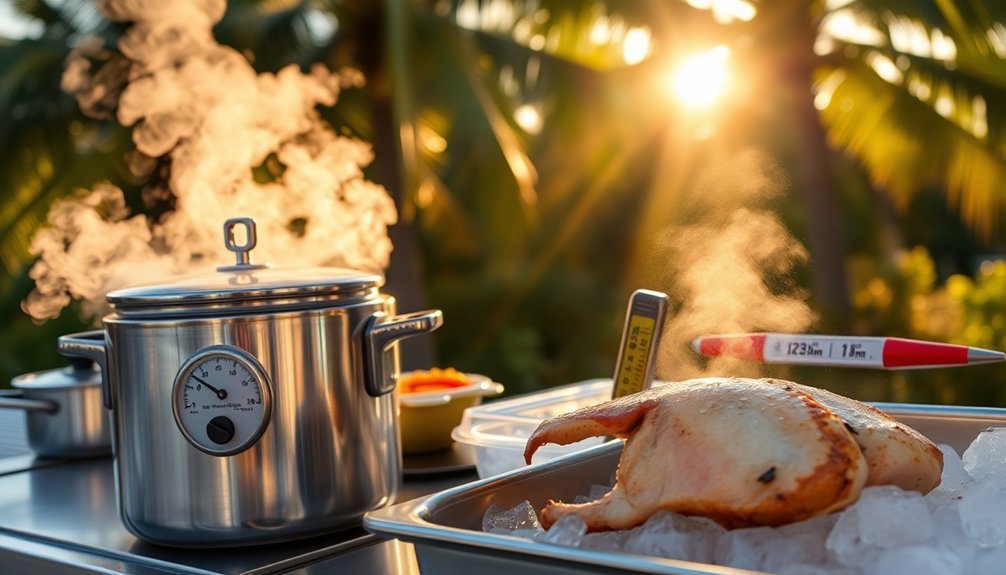
You'll need to monitor food temperatures carefully to avoid the danger zone between 40°F and 140°F, where bacteria multiply rapidly.
Keep cold foods in insulated containers with ice packs and hot foods in insulated containers above 140°F when preparing or serving meals outdoors.
When storing perishables, maintain your refrigerator at 40°F or below and avoid overloading it, which can reduce cooling efficiency and create warm spots where bacteria can grow.
Temperature Danger Zone Controls
To safely prepare food during hot weather, understanding and controlling the temperature danger zone is essential. Keep foods out of the 41°F to 135°F range, where bacteria thrive most rapidly between 70°F and 125°F.
You'll need to monitor temperatures every 2 hours and guarantee food doesn't stay in the danger zone for more than 4 hours total.
Follow these critical temperature controls:
- Cool hot foods from 135°F to 70°F within 2 hours, then to 41°F within 4 more hours
- Reheat foods quickly to 165°F for 15 seconds (135°F for commercially processed items)
- Hold hot foods at 135°F or above, and cold foods at 41°F or below
- Use proper equipment like steam tables and cold storage units to maintain safe temperatures
Don't mix fresh and held foods, and always discard items that exceed time-temperature limits.
Proper Food Storage Methods
Maintaining safe food storage practices becomes particularly essential during hot weather, when temperature fluctuations can quickly compromise food quality and safety.
You'll need to store your food in a cool, dark, and dry location, away from direct sunlight and heat sources. Choose basements or pantries with climate control for favorable conditions.
Use airtight plastic or glass containers to protect against pests and moisture. When storing canned goods, check for rust, dents, or bulging lids, and place newer items behind older ones.
Don't keep food in damp areas or on cement floors, as this can lead to rust and contamination. Make it a habit to inspect your stored items regularly for unusual smells or appearances.
For long-term storage, vacuum sealing provides an excellent barrier against air and moisture.
Solar Reflector Positioning Tips
Successfully positioning a solar reflector can make the difference between a well-cooked meal and an undercooked disappointment.
You'll need to adjust your reflector throughout the day to maximize sunlight capture and guarantee even cooking.
- Align your reflector's angle using a protractor – tilt the top steeply and bottom shallowly for low sun angles to maintain consistent reflection.
- Set up your cooker on level ground in direct sunlight, using weights like stones for stability on windy days.
- Position the reflector to direct sunlight onto your cooking pot without casting shadows, using shiny surfaces like aluminum foil for enhanced reflection.
- Check that your reflector's top ray hits the opposite side of the target surface, confirming proper alignment for ideal heat concentration.
Use transparent covers to trap heat while cooking, and remember to readjust positioning every couple of hours.
Traditional Pacific Island Methods

Across the Pacific Islands, traditional cooking methods have evolved to harness nature's elements through earth ovens, steaming, and grilling techniques.
You'll find the Lovo in Fiji, Imu in Hawaii, and Umu in Samoa – all variations of earth ovens that use heated stones and banana leaf wrapping to cook food effectively.
When you're preparing local staples, you'll discover these methods are perfect for cooking taro, breadfruit, and yams.
The earth oven technique helps remove toxic substances from yams while retaining nutrients in other foods. You can also wrap seafood in banana leaves before placing it in the earth oven, which infuses it with unique flavors.
These traditional methods aren't just about cooking – they're central to community feasts and celebrations, combining practicality with cultural significance.
Time Management for Steam Cooking
When you're mastering steam cooking, proper time management becomes essential for achieving perfect results. You'll need to monitor cooking times carefully, as steaming is a fast and powerful method that can quickly transform raw ingredients into perfectly cooked dishes.
- Start with boiling water and visible steam before adding food – this guarantees consistent cooking temperatures of 212°F (100°C).
- Time your vegetables for 5-7 minutes to maintain vibrant colors and ideal texture.
- Cook meats and fish for 3-10 minutes, depending on thickness and desired doneness.
- Keep hot water ready in a separate pot for longer cooking sessions.
Remember to avoid overcrowding your steamer basket and maintain a tight-fitting lid throughout the process.
For multiple dishes, consider using stackable bamboo steamers that prevent flavor transfer while cooking different foods simultaneously.
Energy-Efficient Tropical Food Preparation

Preparing tropical dishes efficiently requires understanding both modern appliances and traditional cooking methods that minimize energy usage while maximizing flavor.
You'll find induction cooking and pressure cooking particularly effective in tropical climates, as they generate less ambient heat while cooking quickly.
For slow-cooked dishes, opt for slow cookers or air fryers, which use considerably less energy than conventional ovens. When steaming, use traditional methods like banana leaves to add flavor while maintaining energy efficiency.
Consider moist heat methods like braising and stewing for tough cuts of meat – they're energy-efficient and perfect for creating flavorful dishes with local spices and coconut milk.
For outdoor cooking, grilling offers both energy savings and authentic smoky flavors, especially when using regional woods like pimento.
Frequently Asked Questions
Can Steamed Tropical Dishes Be Effectively Frozen and Reheated Later?
Yes, you can successfully freeze and reheat your steamed tropical root vegetables. Just make sure you've steamed them until tender, dried them well, and stored them in airtight containers before freezing for best results.
How Do Different Tropical Wood Types Affect the Flavor When Steaming?
When you're steaming with tropical woods, you'll notice Strawberry Guava adds a sweet-tangy flavor, while other tropical hardwoods can impart unique smoky notes. They'll enrich your dishes with subtle tropical undertones.
What Alternatives Work Well When Banana Leaves Aren't Available?
You'll find several effective alternatives to banana leaves: parchment paper for moisture retention, corn husks for tamales, lotus leaves for Asian dishes, and aluminum foil for versatile steaming. Ti leaves work great for Hawaiian recipes.
Does Altitude Affect Steaming Times in Tropical Mountain Regions?
Yes, you'll need to increase steaming times by up to 25% at higher altitudes because water boils at lower temperatures. For every 3,000 feet elevation, add about 5-10 minutes to your usual steaming time.
Can Traditional Steaming Methods Work With Modern Induction Cooktops?
Yes, you can use traditional steaming methods on induction cooktops. You'll need an induction-compatible pot for boiling water, then place your steam basket on top. The process works just like conventional stovetop steaming.
In Summary
You'll find these tropical cooking methods invaluable for preserving nutrients while saving energy. Whether you're using solar reflectors, bamboo steamers, or traditional banana leaf wraps, you've now got proven techniques to handle the heat and humidity. Make the most of these sustainable approaches – they'll help you create flavorful dishes while staying cool and keeping your kitchen energy-efficient in tropical conditions.

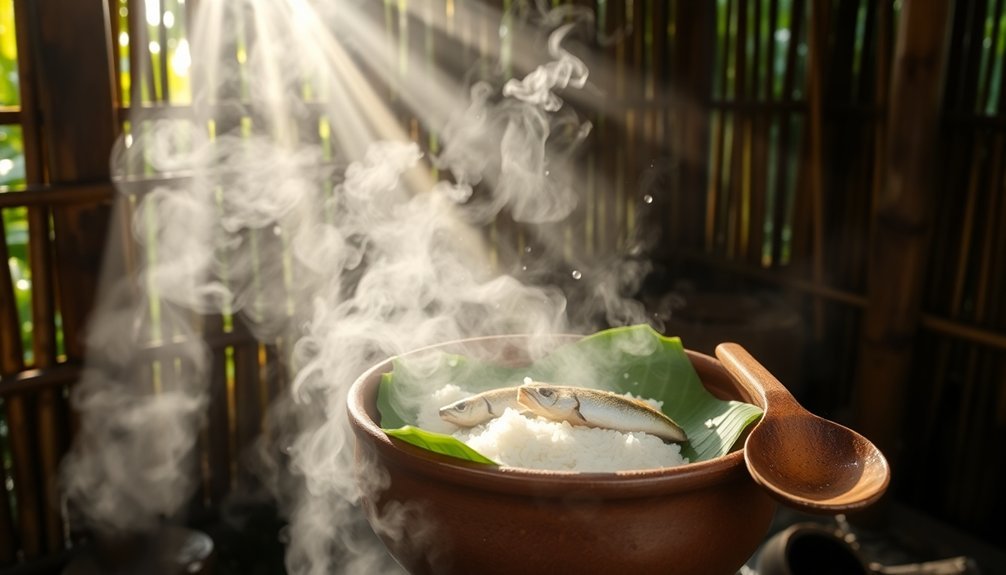
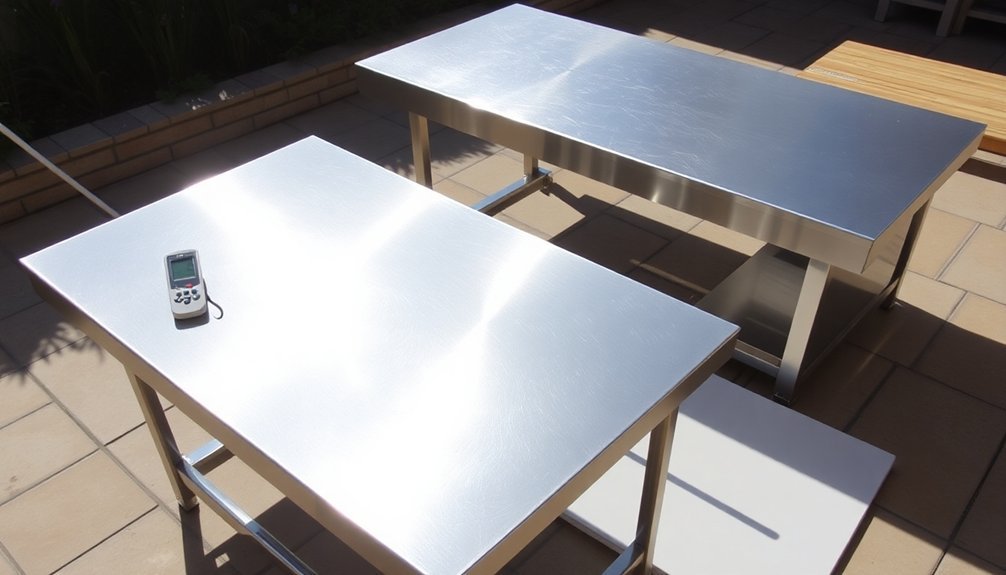
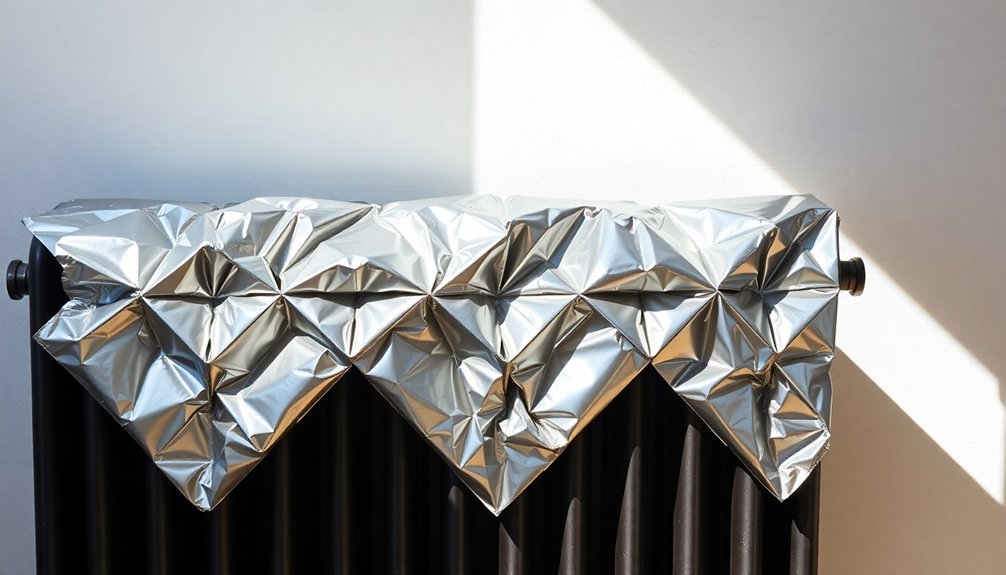
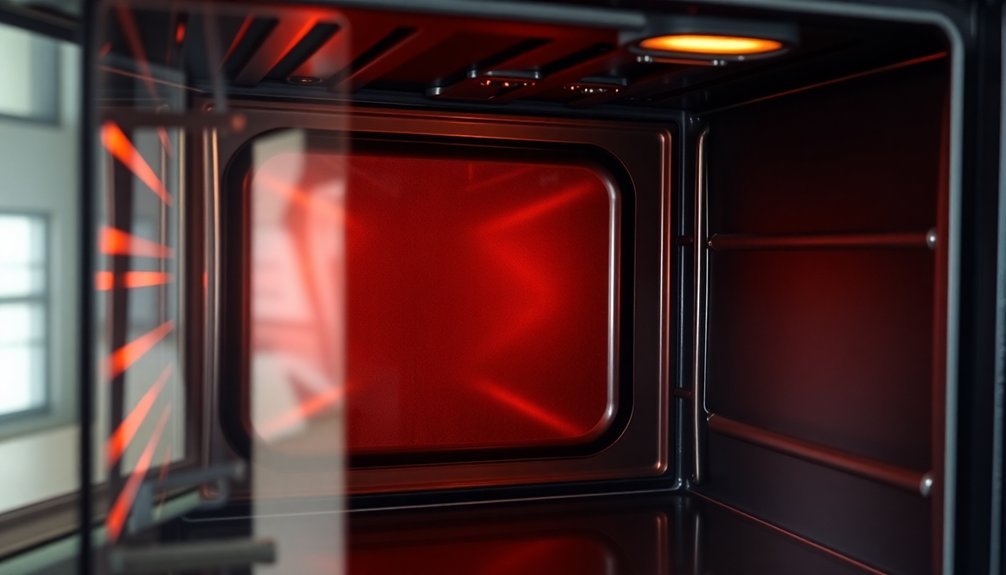
Leave a Reply